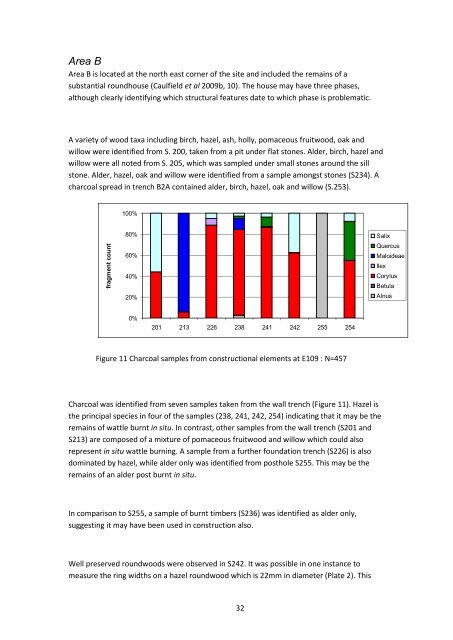Neolithic and Bronze Age Landscapes of North Mayo: Report 2011
Neolithic and Bronze Age Landscapes of North Mayo: Report 2011
Neolithic and Bronze Age Landscapes of North Mayo: Report 2011
You also want an ePaper? Increase the reach of your titles
YUMPU automatically turns print PDFs into web optimized ePapers that Google loves.
Area B<br />
Area B is located at the north east corner <strong>of</strong> the site <strong>and</strong> included the remains <strong>of</strong> a<br />
substantial roundhouse (Caulfield et al 2009b, 10). The house may have three phases,<br />
although clearly identifying which structural features date to which phase is problematic.<br />
A variety <strong>of</strong> wood taxa including birch, hazel, ash, holly, pomaceous fruitwood, oak <strong>and</strong><br />
willow were identified from S. 200, taken from a pit under flat stones. Alder, birch, hazel <strong>and</strong><br />
willow were all noted from S. 205, which was sampled under small stones around the sill<br />
stone. Alder, hazel, oak <strong>and</strong> willow were identified from a sample amongst stones (S234). A<br />
charcoal spread in trench B2A contained alder, birch, hazel, oak <strong>and</strong> willow (S.253).<br />
100%<br />
fragment count<br />
80%<br />
60%<br />
40%<br />
20%<br />
Salix<br />
Quercus<br />
Maloideae<br />
Ilex<br />
Corylus<br />
Betula<br />
Alnus<br />
0%<br />
201 213 226 238 241 242 255 254<br />
Figure 11 Charcoal samples from constructional elements at E109 : N=457<br />
Charcoal was identified from seven samples taken from the wall trench (Figure 11). Hazel is<br />
the principal species in four <strong>of</strong> the samples (238, 241, 242, 254) indicating that it may be the<br />
remains <strong>of</strong> wattle burnt in situ. In contrast, other samples from the wall trench (S201 <strong>and</strong><br />
S213) are composed <strong>of</strong> a mixture <strong>of</strong> pomaceous fruitwood <strong>and</strong> willow which could also<br />
represent in situ wattle burning. A sample from a further foundation trench (S226) is also<br />
dominated by hazel, while alder only was identified from posthole S255. This may be the<br />
remains <strong>of</strong> an alder post burnt in situ.<br />
In comparison to S255, a sample <strong>of</strong> burnt timbers (S236) was identified as alder only,<br />
suggesting it may have been used in construction also.<br />
Well preserved roundwoods were observed in S242. It was possible in one instance to<br />
measure the ring widths on a hazel roundwood which is 22mm in diameter (Plate 2). This<br />
32

















